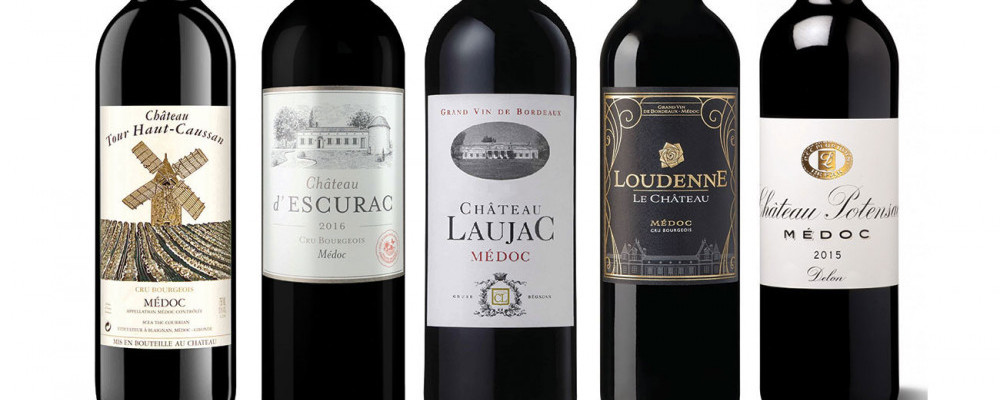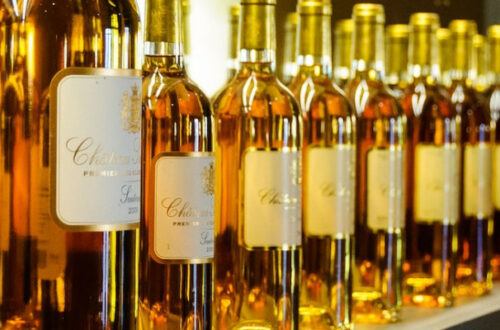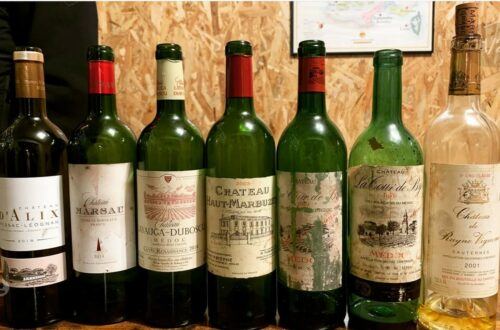
When should I drink Haut-Médoc?
Haut-Médoc wines are from the Bordeaux region. These wines are known to age well, for sometimes three decades!
So, if you have a Haut-Médoc wine in your cellar : when should you drink it?
When should I drink a Haut-Médoc wine?
A Haut-Médoc wine is made from Cabernet Sauvignon mostly which represents three quarters of the blend. These wines can age up to thirty years. The flavours and texture will vary according to the age.
In its youth, these will be full-bodied wines with high acidity and sometimes austere tannins. It will present aromas of cassis, blackberry, black cherry, liquorice, vanilla, coffee bean, spices…

When aging, the tannins will melt into the wine making it rounder and more velvety on the palate. Some tertiary aromas, due to aging in the bottle, such as tobacco leaf, truffle, cigar, leather, spices, wet soil will start to appear.
When these wines are over 25 to 30 years, they will lose their full body and high acidity. The fruity aromas will disappear and only the tertiary aromas will stay.
So, it actually depends on your TASTE and the QUALITY of the wine.
Not all wines can age (see paragraph explaining what makes a Bordeaux wine age well). But for those which are good quality and subject to aging, usually its peak moment is between 20 to 30 years.
However, these wines are then old and old wines are not always enjoyed. So it all comes down to your taste and preferences.
What does a Haut-Médoc wine taste like?
The Haut-Médoc encompasses several smaller appellations, sometimes called “communal appellations” where most of the best-ranked castles are located. From north to south, the four most famous are Saint-Estèphe, Pauillac, Saint-Julien and Margaux.
- Saint-Estèphe, being the northernmost appellation with clay-dominant and gravelly soils, most wineries will tend to put more Merlot in the blend. The wine will taste fruitier with red blackcurrant flavours with notes of violet, vanilla and spices. The Cabernet Sauvignon will bring structure to the wine, making it elegant.

- Pauillac is rich in gravel soils. Cabernet Sauvignon will highly dominate and thus bring its flavours of black fruit, such as dark cherry or blackcurrant, cedar and smoke from the oak. It will have high tannins making the wine dense and powerful. However, the quality is not the same on all the appellation, depending if it’s on the lower or the higher part of the appellation.
- St Julien is also rich in gravel soils. Wines will be complex and powerful with velvety tannins (St – Julien is south to Pauillac so with a warmer climate and the Cabernet Sauvignon will be riper, hence the softened tannins). The wine will have notes of black fruit such as blueberry, blackcurrant, blackberry and spices like liquorice. It will develop tobacco notes with age.

- Margaux is the southernmost AOC, covered by the Garonne river gravel. With its warmer climate, the Cabernet Sauvignon ripens fully so the wines will feel silky, velvety in the mouth. Merlot is usually very present in the blends too so you’ll often find fresh red fruit aromas along with the usual Cabernet Sauvignon aromas. These are very powerful wines. (For a 80€ tour of wineries in the Médoc with transport included, you can actually taste a Margaux wine! If you’re interesting -and you should because it’s of great value, you can find the information in my post where I’ve selected the best tours for you)
What makes a wine age well?
Well first, you’ll need high acidity. The acidity acts as a preservative and prevents bacteria to come and spoil the wine. For sweet wines, a high level of sugar is important (it will act like tannins for red wines).
If you want to enjoy drinking your “old wine”, you’ll need it to have flavours. So in its youth, you’ll need a wine with sufficient concentration of flavors that can evolve in a positive way.
Last, tannins are the most obvious answer. Indeed, tannins are a natural preservative and mellow over time. They lose their astringency and soften and dissipate. They bring power and body to the wine making it silkier on the palate.
How is that? This is due, partly, to polymerization. Tiny molecules attach themselves to small molecules. This creates new and longer molecular structures.
Moreover, the size of tannins molecules change overtime, they increase or decrease.
Due to both reasons, the wine seems more mellow and can seem like velvet in the mouth.
Can a Haut-Médoc wine age?
Merlot has a medium acidity with medium tannins and offers different fruit characteristics according to its level of ripeness. It can deliver red fruit and herbaceous aromas and flavors to cooked black fruit.
Cabernet Sauvignon is a grape with thick skin which bring color and tannins to the wines. It has high acidity and herbaceous and black fruit aromas.
These two grapes are often blended because Merlot will help lower the tannins and acidity levels and make the wines more ready to drink at an early age. It will also add red fruit flavors to the blends.
Cabernet Sauvignon will balance a wine’s acidity and add tannins.
So with Haut-Médoc, you have all three (high acidity, high tannins and concentrated flavours) components : this is why Haut-Médoc wines age well.
Conclusion : when should you drink Haut-Médoc wines?
There’s no right or wrong time to drink Haut-Médoc wines. Well, after 30 years, the wine is declining, so I wouldn’t recommend drinking after 30 years. And the peak period for Haut-Médoc wines is usually between 20 to 30 years.
However, with age, like any human, the wine evolves. So it really comes down to your taste. Young, the wines will be fruitier, rounder. With age, they will lose their body and develop more austere aromas.
What kind of wines do you prefer?
Let me know in the comments!








